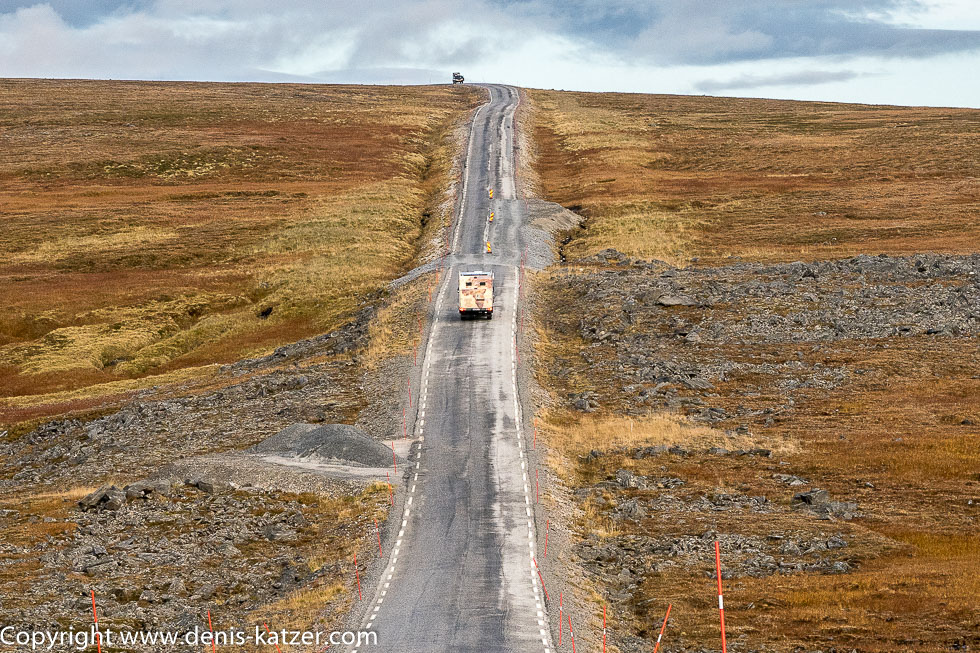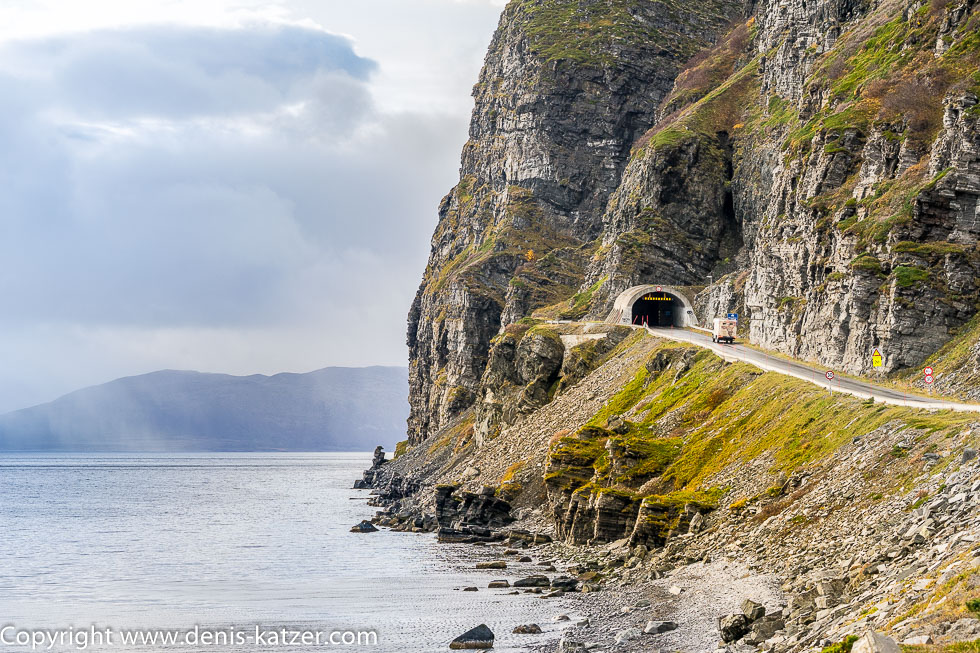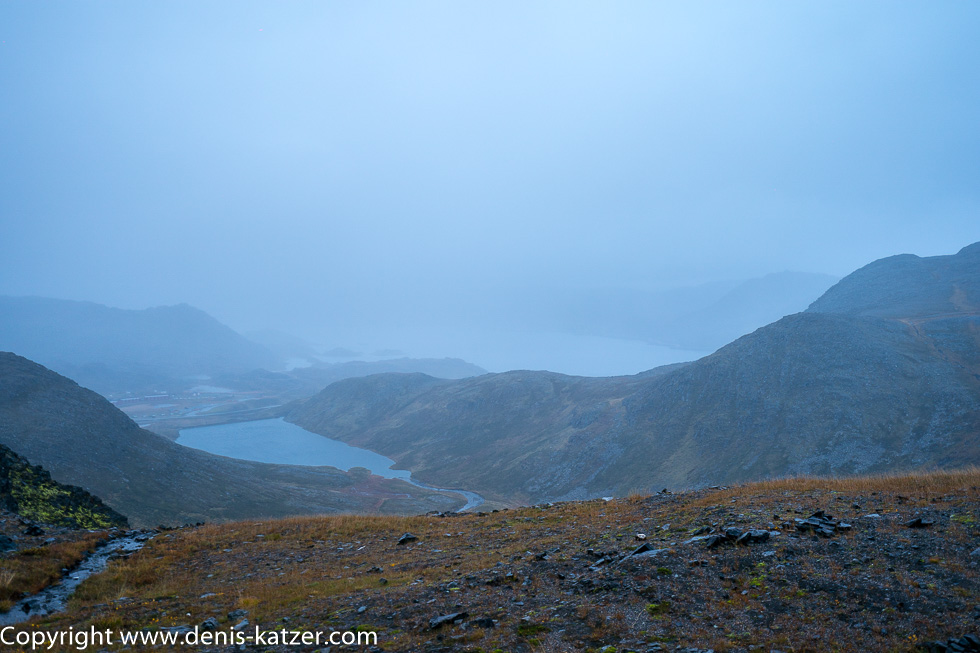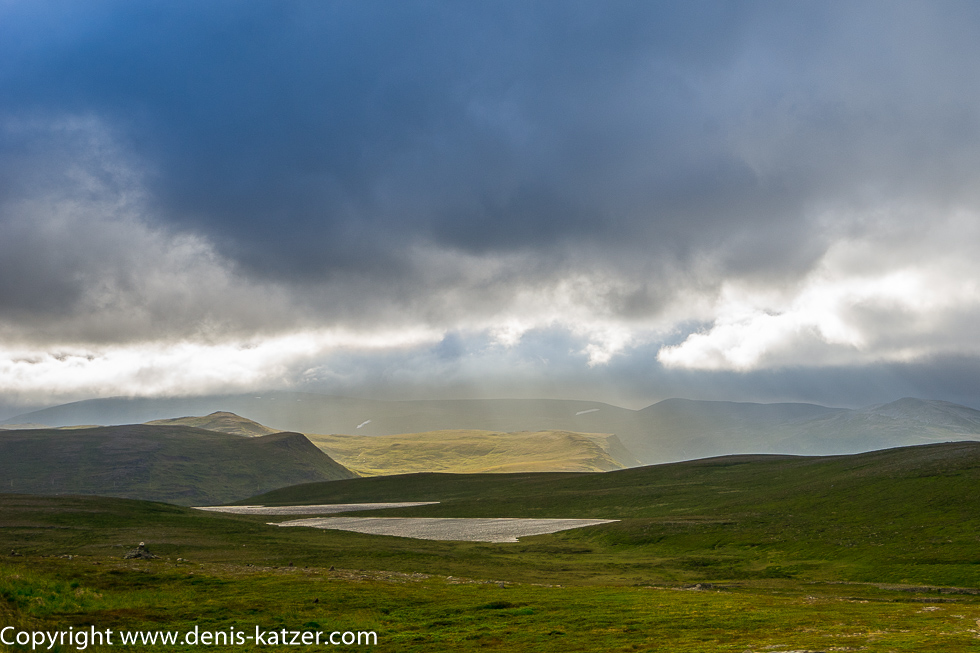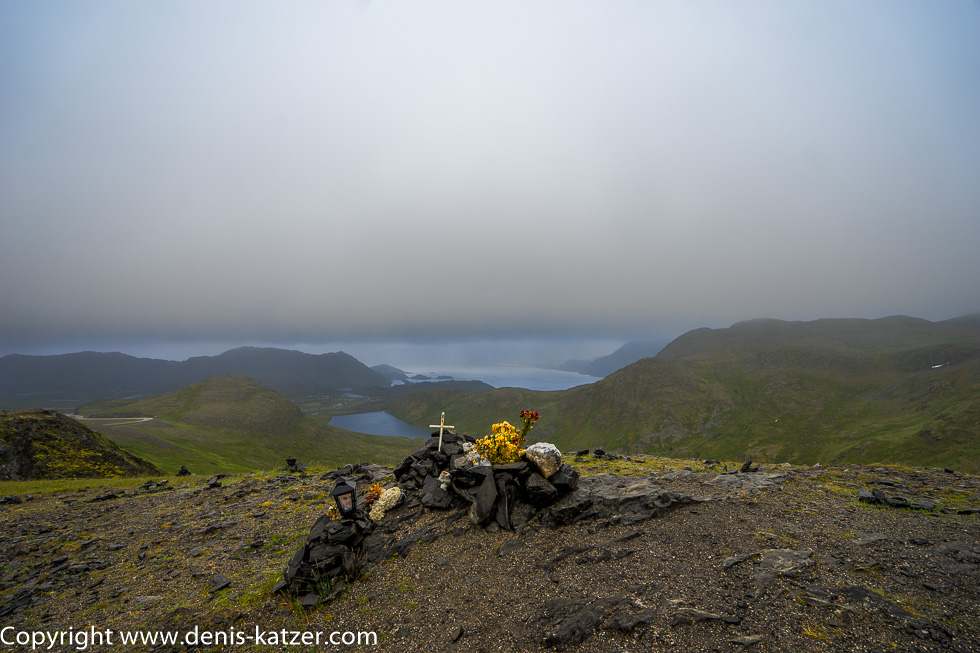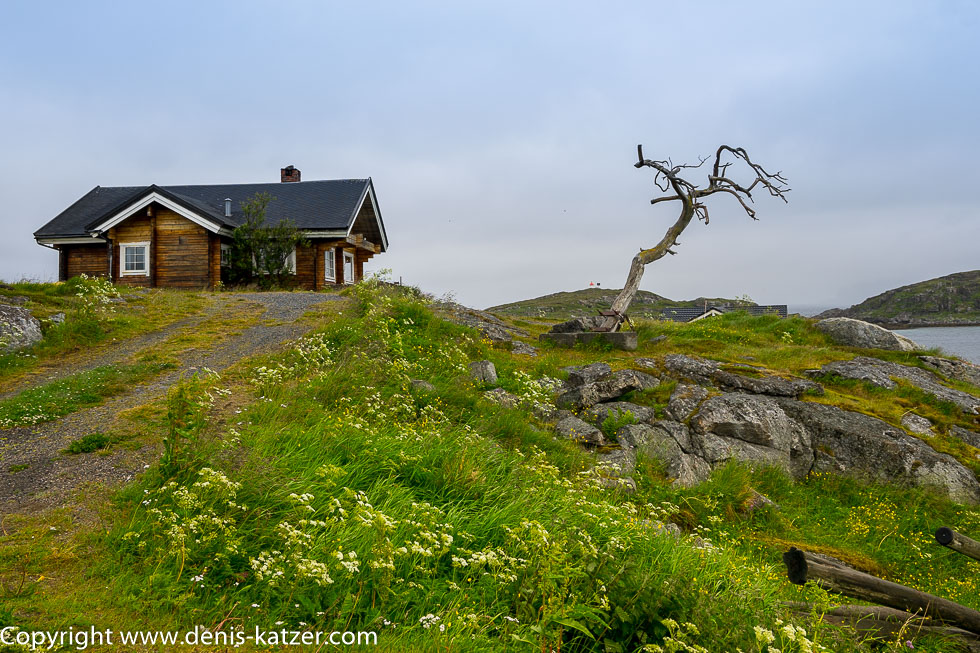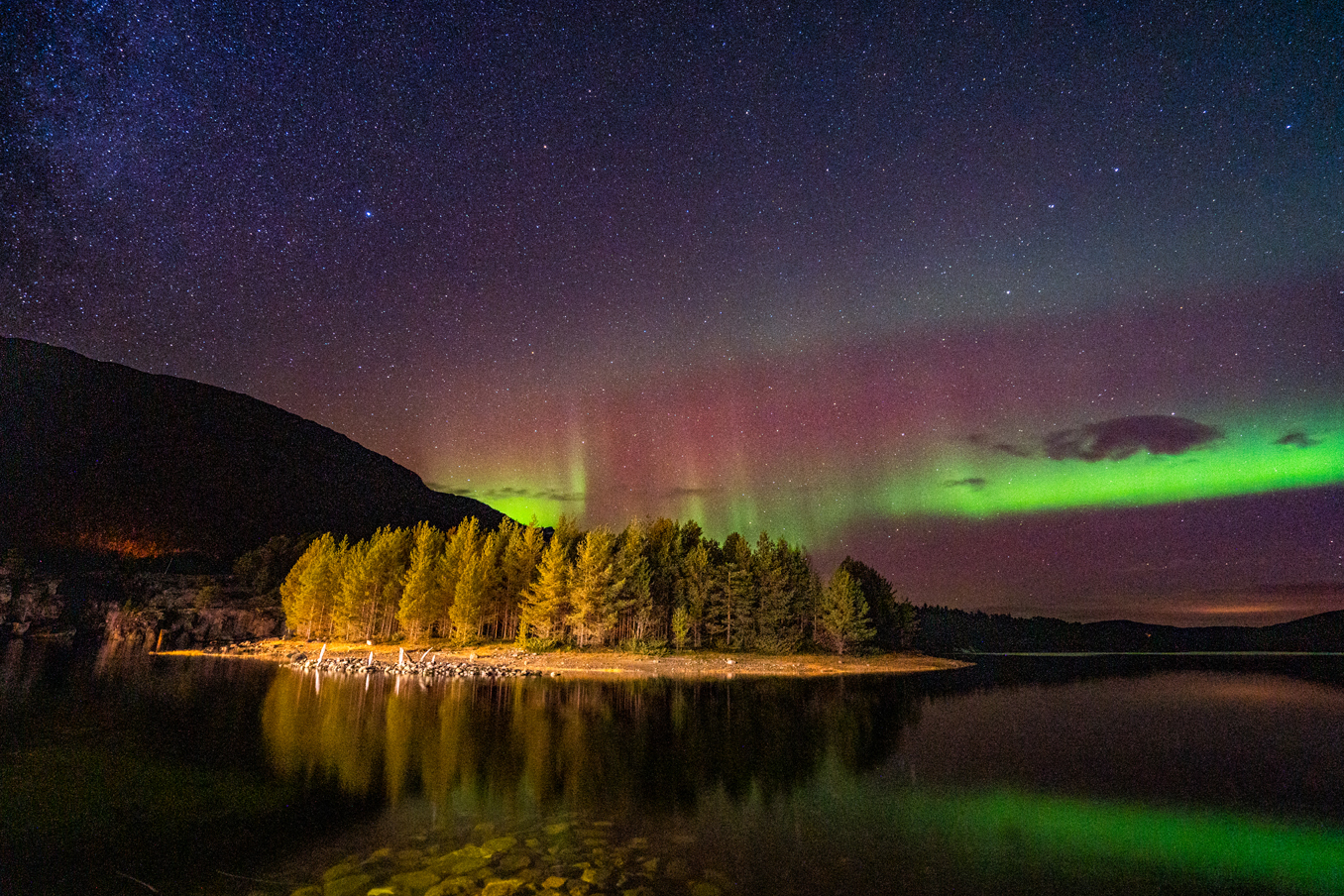
Swallowed up by dense high fog
N 71°10'10.2'' E 025°46'51.8''
Date:
09.10.2020
Day: 068
Country:
Norway
Location:
North Cape
Daily kilometers:
94 km
Total kilometers:
6559 km
Soil condition:
Asphalt
Bridge crossings:
4
Tunnel passages:
3
Sunrise:
07:00 a.m.
Sunset:
5:08 pm
Temperature day max:
6°
Night temperature min:
2°
(Photos of the diary entry can be found at the end of the text).
Click here for the podcasts!
Link to the current itinerary
(For more posts click on one of the flags in the map)
We leave our secluded campsite early and follow the picturesque coastal road. After 50 kilometers, the road bends downwards and is swallowed up by a concrete tube. A low gear warning sign tells us to engage a low gear. We are now in the 6,875 meter long North Cape Tunnel, which was completed in 1999 after five years of construction. “In comparison, the 63-meter-deep Nappstraum Tunnel in Lofoten was a piece of cake,” says Tanja, as we go deeper and deeper into the earth. At a depth of 212 meters under the sea, we travel from the Norwegian mainland to the island of Magerøya, where the North Cape is located. Then it goes steeply uphill again. The sound of the Terra’s engine is reflected by the solid concrete walls of the tunnel and sounds as if an African lion is roaring loudly. When the 110 million euro underwater tunnel lets us out into the daylight again, clouds have gathered. “What does the weather app say?” I ask Tanja, who immediately pulls out her smartphone to call up the data. “The forecast for today is sunshine and light cloud. From tomorrow, it’s supposed to rain or even snow for the next 10 days.” “So if we’re lucky, we’ll see the Cape this afternoon in good weather. I’m curious to see if the forecast is correct,” I reply. “That would be great, then we could unpack our bikes and go for a spin around the Cape,” Tanja thinks. “It would be great if it worked at this time of year,” I say, steering the Terra into another tunnel. The narrow coastal road, which is hardly used at this time of year, winds its way along the breathtakingly beautiful, rocky coast, which is steep in places. Again and again we pass road workers repairing or extending the masterpiece of human engineering with their large construction machines. “Incredible what man is capable of”, I say, not for the first time on this trip. We leave the fishing town of Honningsvåg with its 2465 inhabitants on the right, which was regularly called at by steamships on the Hamburg route as early as 1869 and later also became a stopover for the traditional Norwegian postal shipping line Hurtigruten.
The road suddenly winds upwards into an open, treeless landscape with subarctic alpine vegetation, which is diverse and varied with around 200 plant species despite the short growing season in summer. Although we are about 150 kilometers north of the tree line, we are thrilled by the play of colors of the low flora. Lichens, mosses and grasses dominate the picture. Behind some bends, lush green appears again, which suddenly gives way to a golden yellow, then again to a soon reddish brown. Behind the next bend in the road, endless green meadows once again stretch over graceful-looking hilltops, with small lakes of fresh, cold water nestling in their valleys. Suddenly, everything around us is swallowed up by dense high fog. We can barely see the hand in front of our eyes. “Slow down!” warns Tanja, because the narrow strip of asphalt in front of us has been swallowed up as if by magic. Startled, I get into the irons and slow the Terra down to walking speed. “Switch on the fog lights!” I shout, gripping the steering wheel tightly with both hands, whereupon Tanja presses the necessary button on the dashboard in a flash. Just a fraction of a second later, the arterial road bends to the right. “Phew, lucky me,” I gasp, having slowed down just in time to see the sharp bend appearing in the diffuse light. Then the wall of fog clears again. A black pile of stones appears next to us, on which there are fresh yellow flowers, a cross and a lantern. “Someone must have had an accident,” I suspect. As if the fog had only been an unreal phenomenon, the plateau reappears only moments later in the wonderful warm sunlight. “Phew, what a change in the weather,” I say in surprise. “Fascinating,” exclaims Tanja. “That’s the North Cape up ahead!” I say enthusiastically, pointing to a barrier and a few small houses in front of us. “One of the most spectacular destinations in Norway,” Tanja says exuberantly, as if we had sat on the saddle of our bikes or e-bikes all the way from Germany and conquered the cape with our muscle power. Although we are of course aware that getting to the North Cape by motorhome is no great feat in this day and age, we still feel as if we have achieved something great. About a month ago, we drove under the wooden archway on European Route 6 and reached the far north. Despite all the experiences we have already had in our lives, this was a high point for us that we did not take for granted and now we have reached the far north of Europe by road, 514 kilometers north of the Arctic Circle. A lot can happen to us humans and things often turn out differently than planned. A reason to enjoy this moment to the full and feel like a mountaineer. When we reach the barrier, we clap each other’s hands. Then I roll down the window and say hello to the German called Peter, who is sitting in the heated cashier’s booth and greets us in a friendly manner. As we are the only guests at this hour, we chat a little and learn that he has lived in the fishing town of Honningsvåg, just 34 kilometers from here, for many years. “I’m actually the visitor center’s accountant, but as most of the 200 employees from all over the world have been laid off due to corona, I help out here and collect the entrance fees.” “How many employees work here at the moment?” I want to know. “There are only five of us left.” “Five of us?” I repeat, startled. “Look around you. There are no visitors. You are lucky to be able to experience the North Cape like this. Since the opening of the North Cape Road in 1956, tourism has experienced a noticeable upswing. The absolute record number of visitors in the best year was around 280,000 and now you are almost alone here. Since the North Cape was conquered by tourism, there has never been anything like it,” says the accountant of the Scandic Hotels Group, which also owns the visitor center at the North Cape. “We are journalists and are writing a book about our tour of Norway. Because we work a lot, we’d like to stay for a few days. Is that possible?” I ask, because we’ve heard that the entry ticket is only valid for 24 hours. Peter just shrugs his shoulders in response. “Great, thank you very much,” I reply, because we took the gesture as a yes…
